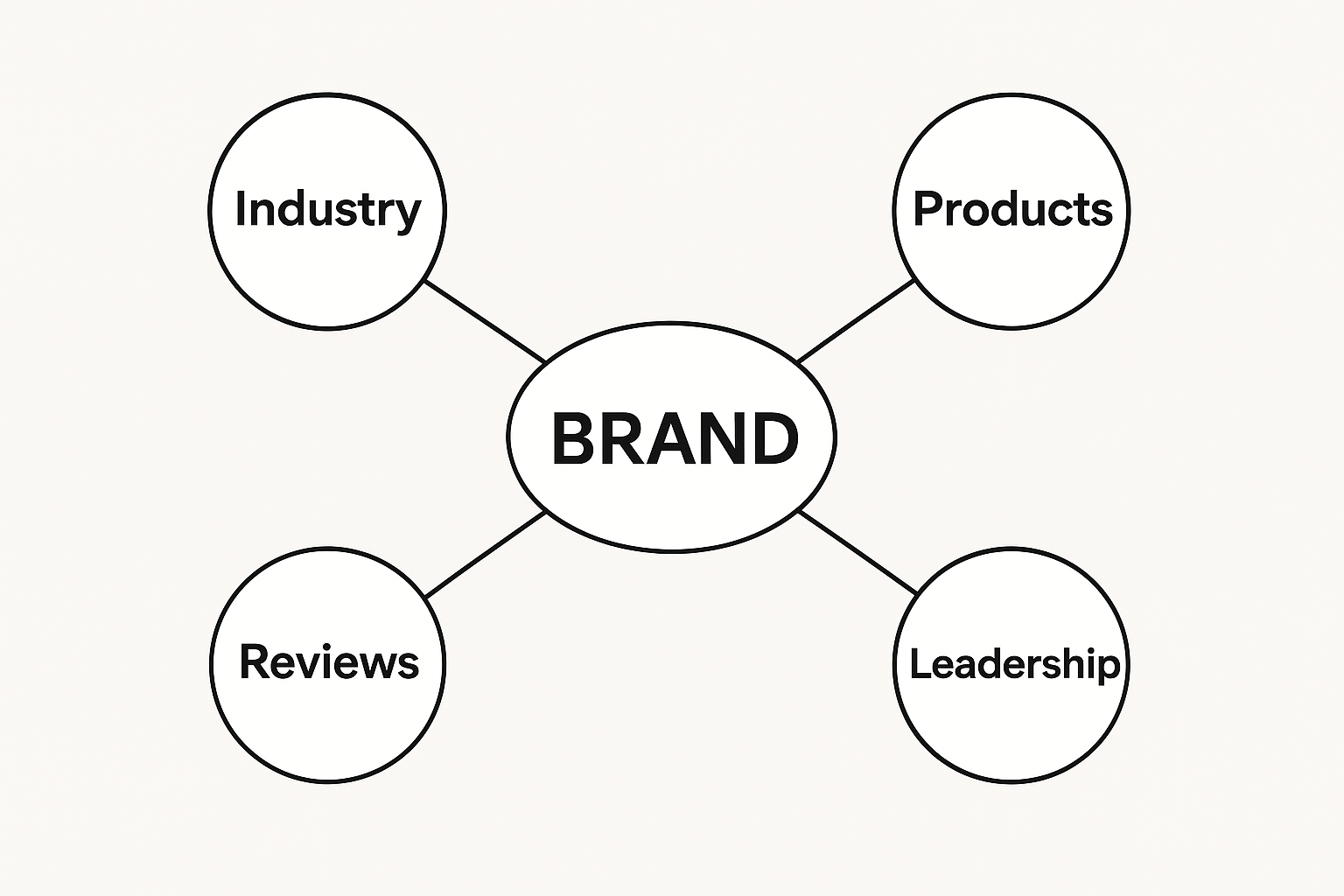There’s a key distinction to make when understanding how AI-powered search engines work. They don’t cite content, they cite brands.
To be specific, the LLMs that power AI search platforms don’t ‘rank’ pages based on keyword density or backlink volume. Instead, they connect entities (organizations, people, places, things, etc.) to existing entries in their knowledge graphs.
This process is called NER (named entity recognition), and it grants AIs the ability to infer the full context and meaning behind a brand’s:
- Industry
- Products and services
- Content
- Voice and mission statement
- Connection to related entities
- Reputation
Entity recognition also helps LLMs distinguish words that have two meanings, like apple (the fruit or the company), jaguar (the animal or the car manufacturer), and Amazon (the e-commerce site or the rainforest).
Once an AI identifies an entity, like your brand, it’ll look for trust signals like your brand mentions, the quality of your backlinks, and your reviews, to decide if you’re worth citing.
This gives AI models a cohesive and accurate understanding of:
- What brands do
- How they can actually help users (either through their content or products and services)
Think about it this way: a keyword is a static piece of language, while a brand is a source of tangible knowledge.
In this post, we’ll teach you how to transition from keyword-based SEO to entity-based SEO.
Why Entity Recognition is Superior to Keywords
Meaning, not words.
That’s the simple reason why NER works better than keyword matching. 
By recognizing entities and tying them to knowledge graphs, AIs are able to capture context that keywords can’t.
Keywords are static and ambiguous, so relying on them to rank content causes some significant complications. For example, there’s the classic issue of keyword stuffing, which is where websites unnaturally force keywords into a page to try to get it to rank for those search terms.
The result?
Unhelpful content that’s awkward to read due to the sheer number of keywords crammed into it.
Yet, if a search algorithm only looks for keywords instead of context, spammy tactics like keyword stuffing can actually work.
To be fair, search engine algorithms haven’t relied on just keyword matching for a very long time now.
Google’s algorithm began to incorporate elements of semantic search back in 2013, and they’ve since incorporated AI (RankBrain and BERT) and multimodal understanding (MUM). 
Because of these advancements, Google’s algorithm has become increasingly adept at identifying and devaluing keyword spam. Yet, keyword matching remains at the core of its process, so it can still struggle with things like:
- Long, conversational-style queries – It’s difficult for keyword-based systems to understand natural-language searches. That’s why classic search engines rely on ‘search engine speak’ to yield the best results, where you string together short-tail keywords (like ‘best steaks long island’).
- Keyword ambiguity – Algorithms can get confused by keywords that have double meanings. Apple could mean the fruit or the technology company. Without a knowledge graph and the ability to understand the surrounding context, keyword-based systems have no way of knowing which ‘apple’ you mean.
- Related concepts and ideas – Keywords are just isolated strings of text, so they provide no context for how they relate to other concepts and ideas. Entities, on the other hand, exist as nodes within knowledge graphs, which are points where related ideas intersect. This structure enables AIs to form context, such as Amazon being an E-commerce company founded by Jeff Bezos.
These are the main shortcomings of keyword-based algorithms. However, modern LLMs equipped with entity recognition and advanced NLP (natural language processing) don’t have these issues.
How AI Models Establish Brand Authority Through Entities

To a keyword-matching system, your brand name is just a word. A static piece of text that’s not tied to your industry, products, or services. When an LLM sees your brand name, it sees the whole nine yards (who you are, what you do, and how your audience perceives you).
However, recognizing an entity is only the first piece of the puzzle.
AI search tools like ChatGPT and Google’s AI Overviews don’t just cite anyone. Instead, they only cite and recommend credible brands with strong brand sentiment and authoritative content.
To do so, they evaluate specific trust signals like backlink quality, branded web mentions, and user reviews.
Also, earning more AI citations is a two-fold process.
First, you need to take steps to enhance entity recognition. It’s not enough that AIs recognize your brand as a real-world entity. To start appearing as a cited source for relevant prompts, you need to get AI models to associate your brand with your areas of expertise.
If you sell fitness accessories, you want to become LLMs’ go-to resource for answering fitness-related prompts. That requires an airtight entity association with your niche.
Building topical authority and using structured data are two ways to solidify your brand’s relevancy to your industry. Creating in-depth, interlinked content that covers your primary area of expertise establishes topical authority and helps with entity association.
Structured data like semantic HTML and schema markup removes ambiguity from your content by clearly labeling things like author biographies, reviews, and articles.
Next, you need to build brand authority, which means earning the trust of AI models.
Which trust signals carry the most weight on AI search tools?

According to research by Ahrefs and related brands, we know that the top AI visibility signals are:
- Branded web mentions – LLMs trust brands that have mentions on credible media outlets, news sites, and industry blogs. Editorial quality matters most here, as AIs will be able to infer the full context of a mention. Ensure that your brand mentions are relevant, genuine, and positive.
- Branded anchors – A branded anchor is a hyperlink to your site that uses your brand name as the anchor text. On AI search tools, branded anchors act as entity reinforcement signals. Also, branded anchor text makes backlinks contextually relevant, so LLMs prefer them over generic anchors like ‘click here.’
- Branded search volume – AIs prefer brands that users search for directly. This is because direct brand searches (like typing Netflix into Google) shows that your brand is a real, in-demand entity, and not just SEO noise. It also acts as a validation signal from actual humans, which is valuable.
- Citation and backlink quality – Backlinks are still important trust signals, but it’s no longer about quantity. Instead, the quality of your backlinks is what matters most. Also, you should ditch metrics like Domain Authority and Domain Rating, since AIs don’t use them. What matters more is that your backlinks are contextually relevant (i.e., it makes sense for them to be there).
- Reviews – AIs don’t want to recommend brands with poor reputations, so they will check your reviews across multiple platforms. Best practices include responding to negative reviews, encouraging happy customers to leave reviews, and maintaining a level of transparency (don’t delete your bad reviews).
- Community discussion from UGC on Reddit and other forums – Lastly, LLMs will evaluate your brand sentiment by examining instances where forum users mention your brand. Is the sentiment positive, negative, or indifferent? AI models will be able to tell, so it’s important to manage your reputation on community forums.
If you want to earn more AI citations, these are the areas you should focus your optimization efforts on.
How to Build Your Brand’s Node in the Knowledge Graph
Next, it’s time to put everything together and learn how to improve your brand’s AI visibility.
Essentially, you’re building a node (which means intersection) for your brand in the knowledge graph AIs use to recognize and connect entities.
Here’s a visual representation of what that looks like:
As you can see, your brand appears where related concepts intersect.
This is a powerful position to hold because your brand will pop up whenever LLMs explore those related topics, heightening the chances that you’ll earn a citation.
Here’s a series of quick tips for building your brand’s node:
- Audit your brand’s entries in knowledge bases like Wikidata, Crunchbase, and Google’s Knowledge Graph. Ensure all your entries are accurate and tell the same story.
- Include semantic HTML and schema markup (from Schema.org) in all your website’s content.
- Establish author credibility by writing detailed biographies that highlight their expertise. Also, link out to their social profiles and include Author schema.
- Engage in digital PR campaigns to earn top-tier brand mentions and backlinks on trusted, relevant media sites.
- Actively manage your review profile and online reputation.
- Build a library of thought leadership content to establish topical authority (make sure they cover similar topics and are interlinked).
- Utilize a multichannel strategy (social media, podcasts, guest posts) to diversify traffic sources, improve engagement signals, and generate links.
Don’t forget to monitor your success by tracking your AI citations. SEO staples like Ahrefs and Semrush now feature AI visibility tracking tools, including your presence in Google’s AI Overviews. BrightEdge’s AI Catalyst is another fantastic choice.
If you’re short on budget, you can always audit your AI visibility manually by running your target prompts and seeing if you get cited.
Earning More AI Citations: Real Examples
Brands have already started noticing the power of improved AI search visibility. While traditional organic traffic may be down, the traffic coming from AI platforms actually converts at higher rates.
Research by Semrush found that one LLM visitor is worth 4.4x more than a traditional search visitor. Ahrefs’ team discovered similar results, with AI visitors converting 23x better than organic search visitors:
Better AI visibility also leads to more branded searches (people looking specifically for your site) and direct site visits. That means that once they get a taste for your brand in AI Overviews and generative responses, they’ll likely seek you out on purpose later on.
Our brand, The HOTH, has also made stark improvements to its clients’ AI visibility, as documented in their recent case studies. Due to their optimizations, clients saw massive upticks in AI citations and keywords triggering AI Overviews.
At this point, it’s clear that generative SEO or GEO is the way of the future for online marketing. Users trust AI tools, so getting them to recommend your brand is extremely powerful.
What are the Next Steps? How Can You Improve Your Brand’s Authority?
In summary, keywords are out, and context is in. LLMs are able to completely understand who your brand is and how respected you are, so you need to earn their trust.
Doing so is less about targeting keywords and more about proving that you’re a truly helpful and credible resource for your target audience.
Do you want to improve your brand’s authority to earn more AI citations?
Book a strategy call with our team of experts to assess your brand’s visibility.

















































































































































